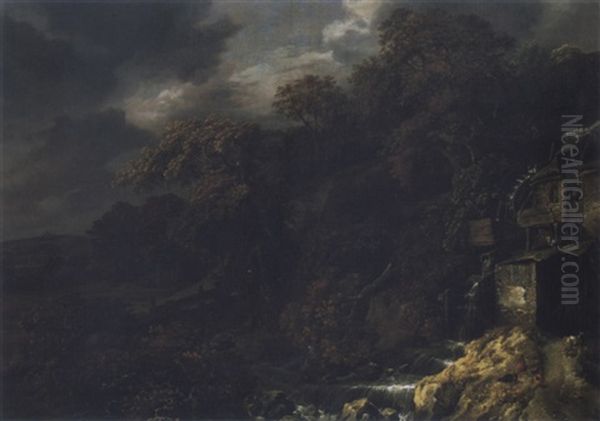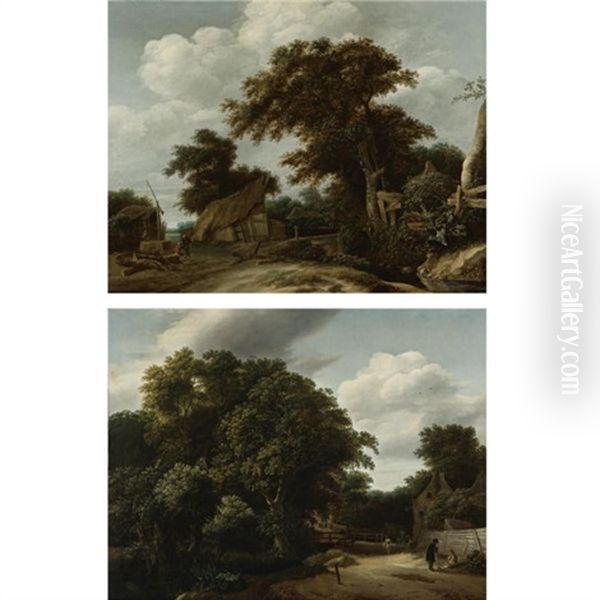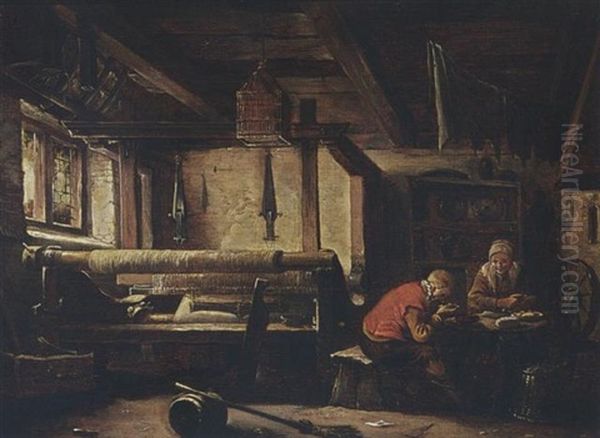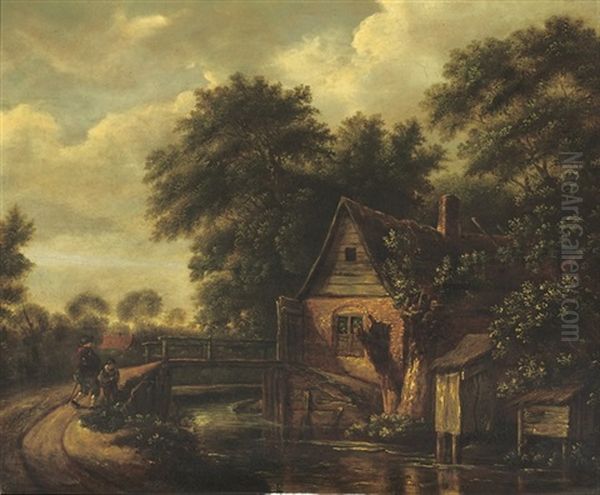Cornelis Gerritsz Decker stands as a notable figure among the landscape painters of the Dutch Golden Age. Active during the 17th century, a period of extraordinary artistic flourishing in the Netherlands, Decker dedicated his career to capturing the rustic charm and quiet beauty of the Dutch countryside. Though perhaps less renowned than some of his contemporaries, his work offers valuable insights into the development of landscape painting, particularly within the influential Haarlem School.
Life and Context in Haarlem
Precise biographical details for Cornelis Gerritsz Decker remain somewhat scarce, a common challenge when studying artists from this period. He is believed to have been born around 1620 or 1623 and died in Haarlem in 1678. His documented activity as a painter spans roughly from the mid-1640s until his death. Haarlem, during Decker's lifetime, was a vibrant center for the arts, fostering a rich environment where painters specialized in various genres, including portraits, still lifes, genre scenes, and, significantly, landscapes.
The Dutch Golden Age saw an unprecedented demand for art among a growing middle class. Landscape painting, in particular, resonated with patrons who appreciated depictions of their own land, celebrating its unique features, from flat polders and winding rivers to dense woodlands and picturesque villages. Decker emerged within this context, contributing to the rich tapestry of Dutch landscape art. Unlike artists whose lives are filled with documented drama or extensive travels, Decker's biography appears relatively uneventful, primarily centered around his artistic production in Haarlem. No specific anecdotes or unusual life events have been reliably recorded, focusing attention squarely on his artistic output.
Artistic Training and Key Influences
The most significant influence on Cornelis Gerritsz Decker's artistic development was undoubtedly Jacob van Ruisdael (c. 1629–1682), the preeminent Dutch landscape painter of the latter half of the 17th century. While the exact nature of their relationship isn't fully documented (whether Decker was a formal pupil or simply a close follower), Ruisdael's impact is undeniable in Decker's work. This is particularly evident in the treatment of trees – Decker often emulated Ruisdael's emphasis on their robust forms, textured bark, and dense, carefully rendered foliage.

Decker also absorbed Ruisdael's approach to capturing specific atmospheric conditions and his penchant for naturalistic detail. However, Decker's style often presents a slightly gentler, less dramatic interpretation of nature compared to the sometimes melancholic or monumental visions of his master. His colour palettes, while distinct, also show an affinity with the tonal sensibilities associated with Ruisdael and other Haarlem painters.
Beyond Ruisdael, art historians detect the influence of other contemporaries. The works of Jan Wijnants (c. 1632–1684), known for his dunescapes and Italianate scenes, may have informed Decker's compositions. Similarly, the compositional strategies found in the forest scenes of Philips Wouwerman (1619–1668), another prominent Haarlem artist famed for his equestrian scenes often set in landscapes, appear to resonate in Decker's work from the 1650s. Wouwerman's way of structuring woodland views, emphasizing clustered tree trunks and highlighted leaf patterns, finds echoes in Decker's paintings. It's possible Decker was also a student of Wouwermans, though his connection to Ruisdael is generally considered more defining.
Style, Subject Matter, and Technique
Cornelis Gerritsz Decker specialized in landscape painting, focusing primarily on depictions of the rural Dutch environment. His preferred subjects included wooded scenes, views along rivers or canals, rustic cottages, farmyards, and, notably, watermills and weavers' workshops nestled within the landscape. These structures are rarely the sole focus but are integrated harmoniously into their natural surroundings, often situated in the middle ground.
Decker's compositional approach typically involves creating a sense of balance and structured space. He often employed diagonals, such as paths or riverbanks, to lead the viewer's eye into the scene. Unlike some landscape painters who emphasized vast, panoramic vistas, Decker frequently opted for more intimate, enclosed views, using trees or buildings to frame the composition. Figures, when included, are generally small-scale, serving to animate the scene and provide a sense of everyday life rather than acting as narrative focal points. They might be seen conversing on a path, drawing water from a well, or fishing by a riverbank.

Technically, Decker's work is characterized by careful brushwork and attention to detail, particularly in rendering foliage, timber framing on buildings, and the texture of brickwork or thatch. His handling of light tends to be naturalistic, capturing the interplay of sunlight and shadow across the landscape. Along with artists like Meindert Hobbema (1638–1709), Decker represents a move within Dutch landscape painting beyond the earlier, more monochromatic "tonal phase" (associated with artists like Jan van Goyen or Salomon van Ruysdael) towards a richer palette and a greater emphasis on local colour and detailed observation, characteristic of the "classical phase."
Representative Works
While a definitive catalogue raisonné might be complex to assemble, several works exemplify Decker's style and typical subject matter. His painting Landscape with Water-Mill, housed in the National Museum in Warsaw, is a prime example. It showcases his skill in depicting rustic architecture integrated into a verdant, waterside setting, likely reflecting the scenery around Haarlem. The interplay of light on the water, the detailed rendering of the mill structure, and the surrounding trees are characteristic of his approach.
Other typical titles attributed to Decker include Landscape with a Village Road and Figures Conversing in the Foreground and Landscape with a Farmyard and Figure Drawing Water from a Well. These titles themselves suggest his focus on everyday rural life and specific landscape features. Works like Bauernkate am Fluss mit Angeln (Peasant Cottage on the River with Anglers), mentioned in auction records, further reinforce this thematic preference.
The subject of weavers' workshops also appears in his oeuvre. A painting titled A Weaver's Workshop is sometimes associated with Decker, depicting the interior or exterior of such a workspace, complete with looms, tools, and figures engaged in their craft. These scenes provide a valuable glimpse into the cottage industries prevalent in the Netherlands during the 17th century, blending genre elements with his landscape focus. It is important, however, to distinguish his 17th-century works from any modern creations that might share a similar title.
Connections to Rembrandt and Other Contemporaries
Direct evidence of close personal interaction between Cornelis Gerritsz Decker and giants like Rembrandt van Rijn (1606–1669) or Johannes Vermeer (1632–1675) is limited or non-existent. While they were all active during the Dutch Golden Age, the art world was somewhat specialized by city and genre. Decker was firmly rooted in the Haarlem landscape tradition, while Rembrandt dominated portraiture and history painting in Amsterdam, and Vermeer created his intimate genre scenes in Delft.

However, an interesting indirect link to Rembrandt exists through Decker's brother, Jeremias de Decker (1609–1666). Jeremias was a respected poet and a known friend of Rembrandt. There is documentation suggesting Jeremias intended to write poems to accompany some of Rembrandt's paintings. Furthermore, Rembrandt painted a sensitive portrait of Jeremias de Decker around 1666. This connection suggests the Decker family moved in circles that intersected with Rembrandt's, even if Cornelis himself wasn't directly associated with the master painter. It's conceivable that artistic ideas might have circulated indirectly through such connections, or that Decker was aware of Rembrandt's work, perhaps even influenced by the atmospheric lighting found in Rembrandt's landscape etchings.
Regarding Vermeer, there is no known evidence of any direct contact or influence between him and Cornelis Gerritsz Decker. Their artistic concerns, locations, and primary genres were quite distinct. While some have speculated about indirect links through artists who moved between cities, such as Rembrandt's pupil Carel Fabritius (1622–1654) who worked in Delft and is seen as a bridge to Vermeer, any connection to Decker remains purely conjectural.
Decker's more immediate artistic circle included his fellow Haarlem landscape painters. Besides his strong connection to Jacob van Ruisdael and potential links to Philips Wouwerman and Jan Wijnants, he worked alongside artists like Roelof van Vries (c. 1631–after 1681), another painter of wooded landscapes in Haarlem. He also sometimes collaborated with other artists, such as Adriaen van Ostade (1610–1685), who occasionally added figures to Decker's landscapes, a common practice in the 17th-century Dutch art market.
Legacy and Collections
Cornelis Gerritsz Decker occupies a respectable position within the history of Dutch Golden Age art. He is recognized as a skilled and sensitive painter of the Dutch landscape, adept at capturing the specific character of the Haarlem environs. As a follower of Jacob van Ruisdael, he helped perpetuate and disseminate the influential style developed by his master, contributing to the overall strength of the Haarlem School of landscape painting.
However, his influence on subsequent generations of artists appears to have been less profound than that of Ruisdael, Hobbema, or even Wouwerman. He is generally regarded as a talented practitioner within an established tradition rather than a major innovator who significantly altered the course of landscape painting. His work is valued today for its intrinsic quality, its representation of 17th-century Dutch rural life, and its connection to the broader artistic trends of the era.

Works by Cornelis Gerritsz Decker are held in various public collections. As mentioned, the National Museum in Warsaw holds his Landscape with Water-Mill. Other museums in Europe and North America likely house examples of his paintings, though they may not always be on prominent display. His works also appear periodically on the art market, sought after by collectors of Dutch Golden Age landscapes. The precise number of his surviving works is difficult to ascertain, but enough exist to provide a clear understanding of his style and contribution.
Conclusion
Cornelis Gerritsz Decker was a dedicated landscape painter whose career unfolded during the height of the Dutch Golden Age. Firmly rooted in the Haarlem tradition, he absorbed the crucial lessons of Jacob van Ruisdael, translating them into his own charming and meticulously observed depictions of the Dutch countryside. His paintings of woodlands, riversides, cottages, and mills offer a peaceful, naturalistic vision of his native land. While perhaps overshadowed by the towering figures of Ruisdael, Rembrandt, and Vermeer, Decker remains an important artist whose work enriches our understanding of 17th-century Dutch art, capturing the quiet beauty and everyday life of rural Holland with skill and sensitivity. His connection to Ruisdael and his place within the bustling artistic community of Haarlem secure his position as a noteworthy contributor to the enduring legacy of Dutch landscape painting.